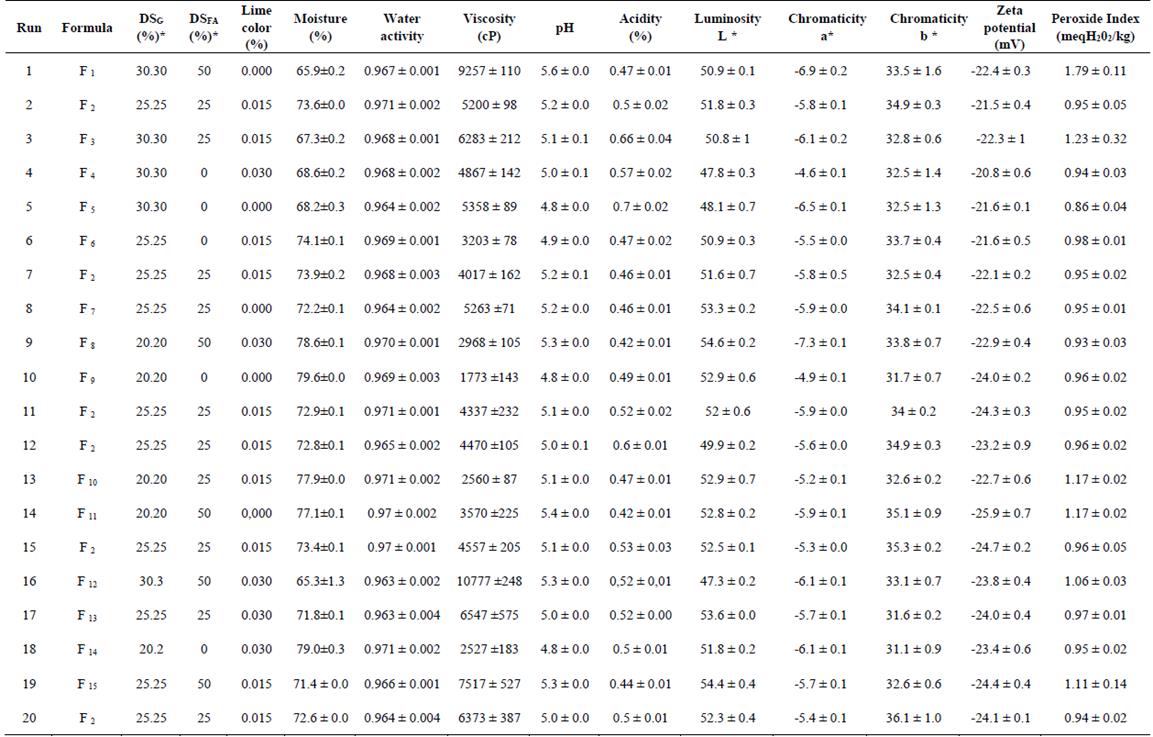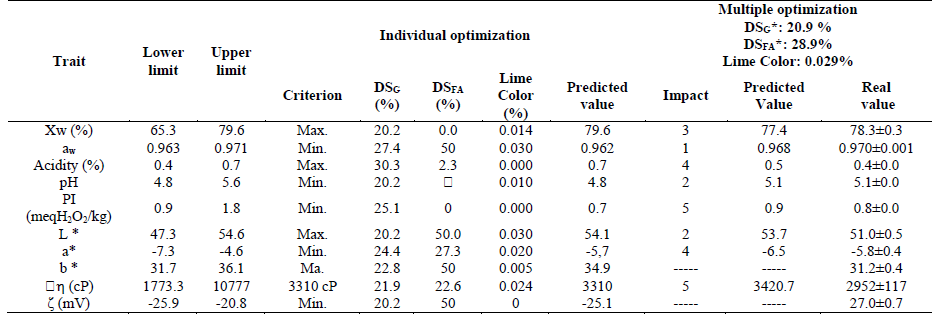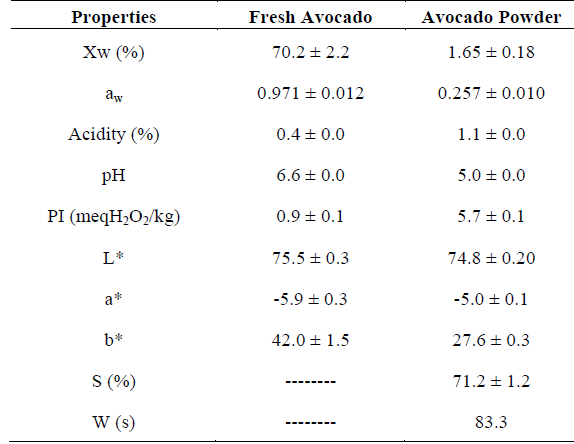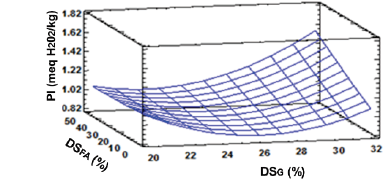1. Introduction
Guacamole dressing is a food product made with fresh avocado (FA), lemon, vegetables, spices, antioxidants, preservatives, condiments, among others, stored at refrigeration temperatures [1]. It is known by being oil-in-water (O/W) emulsion that behaves like a thermodynamically unstable colloidal system, requiring additives for adequate emulsification and stability which can cause loss of flavor, aroma, color, and appearance [2]. Guacamole-making process is performed with FA using different chemical and natural additives in order to increase its shelf-life. The most commonly used additives are: antioxidants with lipid and/or enzymatic effect (sodium erythorbate, butylhydroxytoluene (BHT), sulfur dioxide, ascorbic acid, citric acid and α tocopherol) [3], preservatives (Sodium benzoate and potassium sorbate) [4], and spices like garlic and onion, which have been associated with antibrowning properties [5].
FA is the basic raw material for guacamole making process and is also very susceptible to deterioration problems due to lipid degradation and browning because of its oxidative and enzymatic reactions [6]. One of the alternatives to counteract this problem is to dry the pulp, however, loss of avocado flavor has been reported when applying this conservation technique [7]. Guzmán-Gerónimo et al. (2008) [8] treated avocado pulp by microwaves, finding a decrease in volatile compounds responsible for its flavor: estragole, terpenoids, hexanol and 2-hexenal. Grajales et al. (1999) [9] reported bitter tastes by sensory analysis of avocado powder (AP) obtained by emulsified spray drying using mono acyl glyceride and antioxidants: Butylated hydroxyanisole (BHA), butylated hydroxytoluene (BHT), and tertiary butyl hydroquinone (TBHQ). On the other hand, avocado pulp freeze drying, an expensive technology due to processing times and energy costs, has been one of the methods with best results in terms of sensory characteristics [10]. In the Mexican market, freeze dried pulp is used in the preparation of various products: sauces, guacamole, dressings, snacks and chip flavoring, among others [11].
Currently, the design and formulation of new foods implies the use of adequate raw materials that facilitate and guarantee their quality. Therefore, AP represents an industrial interest for food, cosmetic and pharmaceutical sectors. In the case of food industry, it is necessary to have raw materials of smaller volume and weight than fresh products, stackable, that do not darken during storage or by simple exposure to air, in addition to retaining their quality and sensory properties. These conditions are adequately met by AP for the elaboration of different foods, among which guacamole stands out. Additionally, lime color is a natural colorant that can contribute to improve this quality characteristic of guacamole made with PA since, as mentioned, it may have deficiencies in this sensory property.
On the other hand, support of statistical tools allows an analysis of multiple intrinsic factors in food quality, and the use of the response surface methodology (RSM) represents an effective way to innovate and create products with special traits. This methodology has been applied in different food products like a sauce prepared with olive oil, isolate protein, whey and xanthan gum [12]; a drink based on walnut oil and gum arabic [13]; and an orange drink with xanthan and gum arabic [14]. The aim of this research was to develop a formulation of guacamole prepared with FA and AP that had quality characteristics similar to a commercial guacamole, using RSM.
2. Materials and methods
2.1. Raw material
Hass avocado (Persea americana Mill) from Abejorral, Antioquia, Colombia, was used, with a ripening time between 11 and 15 days. Red onions (Alliumcepa L.), sweet pepper (Capsicum annuum), coriander (Coriandrum sativum), garlic (Allium sativum) (0.508% db), and salt (1.421% db) were purchased at the local market. Potassium sorbate, butylhydroxytoluene (BHT), sodium benzoate, citric acid, sodium erythorbate (0.621% db), and lime color (Ecoflora S.A.S.) were used as guacamole additives. Additionally, AP obtained by spray drying according to the methodology described by Marulanda, (2014) was used [15], it is composed of avocado pulp, maltodextrin, gum arabic, salt, and lemon juice.
2.2. Characterization methodologies
Dressing formulations, FA and AP were characterized in terms of moisture content (Xw) (AOAC 930.15 /1997), water activity (aw) by dew point hygrometer (Aqualab 3TE series, Decagon, Devices, USA) (AOAC 978.18 / 1997), pH using a potentiometer by electrode immersion in the sample, and previous calibration with buffer solutions of pH 4 and 7 (method AOAC 981.12 / 1997), acidity was determined by titration with NaOH 0.1N using 1% phenolphthalein as indicator and expressed as citric acid (%), peroxide index (PI) by FOX method, performing spectrophotometric readings at 500 nm wavelength and expressing the eq. (1) as meqH2O2/sample kg [16].
Where, Am and Ab are sample absorbance and blank, respectively, m is the slope of calibration curve (μg/mL), W is the sample weight (g), Vt is the final volume (mL) of reaction mixture; 2 is the conversion factor to express meq H2O2, and 55.84 is the molecular weight of iron (μg/μmol).
Color coordinates (Luminosity: L*, green-red chromaticity: a*, blue-yellow chromaticity: b*) were determined using a X-Rite model SP64 spectrophotometer, D65 illuminant and 10° observer [3]; apparent viscosity (η) was determined with DV-III Ultra rheometer (Brookfield Engineering Laboratories, Inc., USA) coupled with thermostatic bath at 25°C (Brookfield model TC-502) using the RV6 spindle and a speed range of 0.01 to 100 rpm (η was reported at 100 rpm) [17]; zeta potential (ζ) was determined in samples diluted in distilled water in a 1:100 ratio, using Zeta Sizer Nano (ZS90, Malvern Instruments Ltd., Worcester, UK) and DTS 1060 capillary cells [16, 18]. In addition, wettability (W) and solubility (S) were determined for AP. For W, 1 g of the powder sample was weighed and spread on the surface of 400 mL of distilled water at 25°C without agitation. The time until the last particle of dust was submerged was recorded [19]. S was determined by dispersing 1 g of AP in 50 mL of water using vortex for 60s. The obtained mixture was centrifuged at 3000 rpm/5min at 25 °C. Subsequently, an aliquot of 25 mL of the supernatant was taken, transferred to previously weighed Petri dishes, which were immediately dried in an oven at 105 °C for 5 h. S (%) was calculated as the difference of weights divided by initial weight [20].
2.3. Formulations development
For developing guacamole formulations, RSM was used with a face-centered central composite design of 6 repetitions in the central point, for a total of 20 experiments. Independent variables were: dry solids of guacamole (DSG) (20.2 - 30.3%), dry solids contributed by FA in the guacamole (DSFA) (0 - 50%), and lime color (0 - 0.03%).
The total water of the formulation was incorporated in three moments. Initially, AP was reconstituted with 50% of the formulation water using a mixer (Kitchenaid Artisan, mod. KSM150PSER, St. Joseph, MI) at 194 rpm (position 6) for 4 min. Then, a premix of vegetables, spices, condiments, preservatives, antioxidants (constant in all the experimental runs) and 25% of the formulation water were added, which was previously prepared in a blender (Oster® 4655 Sunbeam Products, Inc, Miami, FL) (position 2). Finally, FA was mashed and mixed with the remaining 25% of water, and added to the product in the blender maintaining the agitation for additional 2 min. Xw, acidity, pH, aw, PI, ζ, η, L*, a* and b* were determined. For experimental optimization, the properties of commercial guacamole were considered as a reference and a quadratic model was used for analysis, eq. (2), where
 is the predicted response
is the predicted response
 is the model constant;
is the model constant;
 ,
,
 , and
, and
 are regression coefficients for linear effects;
are regression coefficients for linear effects;
 quadratic effect coefficients; and
quadratic effect coefficients; and

 are interaction coefficients. Adequacy of the models was determined using lack of fit test and regression coefficient (R2). In addition, analysis of variance (ANOVA) was performed with a significance level of 5%. The analysis of results and optimization were performed using Statgraphics Centurion XVI.II software.
are interaction coefficients. Adequacy of the models was determined using lack of fit test and regression coefficient (R2). In addition, analysis of variance (ANOVA) was performed with a significance level of 5%. The analysis of results and optimization were performed using Statgraphics Centurion XVI.II software.
3. Results and discussion
3.1. Characterization of raw material
Table 1 shows mean values plus standard deviation of AP and FA physicochemical properties. There were significant differences (p<0.05) in Xw, aw, acidity, pH, PI, L*, a* and b*. Spray drying process produces a reduction of Xw and aw of AP, resulting in a microbiologically stable product, with Xw values close to monomolecular layer of water [21]. Acidity values for AP were higher than FA due, on the one hand, to acidic components concentration coming from FA [7], contained in AP, and to the acidic contribution of lemon juice present in AP [15]; this is consistent with pH values found for each raw material. AP presented the highest IP values, which could be due to: the oxidizing effect of lipoxygenase at the moment of feeding preparation for the dryer, and to drying during its making process which involves an air inlet temperature of 160 °C that can cause hydrolysis of triglycerides, releasing organic acids then oxidized to form hydroperoxides, and this in turn is related to acidity increase and pH decrease [22].
Regarding color, L*, a* and b* values in FA, they are similar to those reported in the literature [23]. Raw materials have similar values of L* and a* chromaticity (red-green); while b* chromaticity was different, probably because of the water contained in FA that enhances a greater absorption of light and highlights the yellow tone.
L* of AP is the result of various reactions like enzymatic and non-enzymatic browning given the high temperatures experienced by the matrix during spray drying [24]; besides the addition of maltodextrin and gum arabic. Whereas, a* chromaticity is a consequence of the partial degradation of FA alpha and beta chlorophylls and lemon juice, up to pheophytins and pyropheophytins during spray drying process [25]. In a*b* chromatic plane, FA and AP are in the second quadrant, denoting a similarity in the presence of chlorophyll component (a* <0) and the presence of carotenoid components (b*> 0), b* chromaticity of AP was lower than that of FA, probably due to compounds degradation during spray drying process [26].
S and W are important to establish powdered products reconstitution mechanism, since they predict their rehydration rate [24]. Results of these properties in Table 1 are considered acceptable values, despite being a structure rich in lipid component with no affinity with water and with gum Arabic presence, which delays its wetting. The values found for S and W are higher than those reported in other food matrices like pomegranate and apple powder [27]
3.2. Quality properties of guacamole formulations
Table 2 presents mean values with standard deviations of the dependent variables as a function of independent variables, and Fig. 1 shows response surfaces of each dependent variable. Xw is a fundamental attribute in dressing development because it is directly related to nutritional, mechanical, optical, microbiological, and sensory properties. As DSG and DSFA increased in the guacamole formulations, Xw decreased.
Table 2 Experimental design of guacamole dressing formulations based on AP and FA.

*DSG: Dry solids of guacamole and DSFA: Dry solids contributed by FA.
With respect to microbiological stability of guacamole, aw values fluctuated between 0.963 and 0.971, being established in an area for products prone to the development of pathogenic microorganisms for any formulation [28], so it is necessary to use industrial chemical preservatives like potassium sorbate and sodium benzoate.
In avocado fruit, reported Xw values go from 67% to 78% [29], and in tomato sauce 78.3% [30]. In dressings and sauces established aw values go from 0.990 to 0.830 [2].
Formulation acidity showed a decreasing tendency with DSG decrease and at the same time with DSFA increase, reaching highest values of acidity when DSFA contribution was zero (100% AP) and DSG was higher. pH values were consistent with acidity, being lower when DSFA contribution was zero (100% AP) and pH was higher when DSFA contribution was 50%. The differences of pH and acidity are mainly related to AP and FA acidity, and pH described in Table 1. On the other hand, Hass FA contains acids typical of this fruit, even in higher concentration compared to other varieties like Creole avocado. It is noteworthy that pH values were higher than 4.6, a value suggested as safe pH in sauces and dressings [31]. However, microorganism inhibition capacity in sauces and salad dressings stored at temperatures of 5°C and a pH of 6.5 is reporte [2].
Lipid oxidation is one of the most serious causes of quality deterioration in many foods. Compounds responsible for unpleasant odors and tastes are produced in parallel with lipid peroxidation [32]. PI is related to hydroperoxides formation; a first product formed by lipid oxidation, and is used to determine the initial degradation rate [32]. The maximum oxidation value obtained in guacamole formulations was 1.79±0.11 meq H2O2/kg, which is favorable when compared to the limits allowed for avocado oil according to the Mexican norm NMX-F-052-SCFI-2008, and with those reported by Ariza et al. [33] in Hass avocado subjected to electric field (2.46 meq O2/kg). This result could be attributed to the effect of dilution of AP solids in the elaboration of guacamole.
The most important increase in PI (1.79 meq H2O2/kg) occurs at high values of DSG and DSFA, which is consistent with higher fat content of the formulations and therefore, greater number of hydroperoxides. This oxidative phenomenon starts from the avocado fruit processing: pulp cutting and mashing with exposure to O2 and light.
Mashing promotes the action of lipolytic enzymes on triglycerides causing hydrolysis and fatty acids release [24]. Also, the action of light causes an activation of the chlorophyll (photo-oxygenation) contained in FA, which in this state is a potential catalyst for lipid oxidation reactions, responding directly with the substrate to form free radicals that continue lipid oxidation reactions [34]. The same behavior was reported for a guacamole emulsion for spray drying purposes [16].
On the other hand, the increase of lime color in the formulations inhibited the oxidative process, mainly when the formulation had higher contributions of DSFA. This influence is partly due to natural lime-colored dye characteristics, which is obtained from jagua blue (Genipa americana) and curcumin, a natural ingredient obtained from Curcuma longa L., that can confer antioxidant activity involving radicals and peroxides uptake [34].
L* fluctuated between values of 47.3 and 54.6, observing darker tones (<L*) when the formulation contained a higher amount of DSG. This behavior is related to PI results and to light absorption increase (less translucent) with higher content of DSG, which produces a decrease in reflectance, causing a decrease in L* and getting darker. The a* and b* chromaticities fluctuated between values (-7.0 and -5.5) and (31.1 and 36.5) respectively, defining the product in the chromatic plane a*b* with a light green tone. As lime color increased in the formulations a* chromaticity (greenish chromaticity) decreased, mainly when the formulation had a low content of DSG. While in formulations with a high content of DSG, the effect was opposite, decreasing the greenish hue. Similar values were found in other studies with smashed avocado [8].
Viscosity has a direct effect on consumer acceptance, since it is an indicator of food quality [2]. Furthermore, this rheological property affects the release of flavors such as garlic, pepper and acid in products like dressings [35]. The viscosity of formulations fluctuated between 1773.3 and 10776.7 cP, showing a deformation in colloidal structure when shear rate increases, causing viscosity decrease. This behavior is a non-Newtonian pseudoplastic fluid and was also reported in salad dressing based on plantain and egg powder [35], in tomato sauce [36], and in mayonnaise and golf sauce [37]. The viscosity of guacamole was higher when the DSG and DSFA increased, maximizing with 30.3% DSG and 50% DSFA. Some of the viscosity results presented values similar to those reported for traditional mayonnaise, using a methodology that took into account agitation effort and a fixed temperature not reported by the author (4000 cP) [38], and low-fat mayonnaises among 856 and 2002 cP.
Although ζ did not present significant statistical differences (p> 0.05), its values ranged between -20.8 and -25.9 mV which denoted a partial contribution to colloidal system stability due to the predominant negative electrostatic forces in co-ions layer formed at the oily particles interface. In literature, stability studies are reported in different matrices with different ζ values: egg yolk-based dressing, rapeseed oil and dextran (ζ between -20 and -50 mV) [39], emulsion based on olive oil and hydrolyzed coconut protein (ζ between -13.7 and -17.7 mV) [23] and emulsions based on orange oil, gum arabic and xanthate gum (ζ between -26.8 and -29.3mV) [17]. In colloidal systems, like dressings, stability can be improved by increasing repulsive forces or electrical potential at the interface to ( ζ ( > 30 mV [18], or with the use of hydrocolloids, such as xantha gum (stabilizer-thickener), which increases viscosity without depending on pH, it is also soluble in cold and hot water, and increases repulsion forces [40].
ANOVA (Table 3) identified that the DSG variable had influence on Xw, aw, acidity, L*, a*, ( dependent variables; whereas DSFA also had an effect on Xw, acidity, pH and (. Additionally, ( and PI variables presented significant differences (p<0.05) with respect to DSG-DSFA interaction, and also PI with respect to lime color and DSG quadratic interaction.
Table 3 ANOVA of response surface models for the obtaining process of guacamole dressings.

Source: the authors.
The analysis of formulations in this study was carried out according to the properties of a commercial guacamole (Xw: 80.1%, DSG: 19.9%, aw: 0.971, acidity: 0.45%, pH: 5.6, PI: 0.219 meq H2O2/kg, ζ: -35.2 mV, L*: 55.9, a*: -5.6, b*: 30.0, and (: 3310.0 cP). It should be noted that the country does not have a specific regulation for avocado-based dressings.
The values of R2 (Table 4) for the response surface models of b* and ζ were very low, which is not important taking into account that these variables did not show significant differences. However, aw also presented a low R2 value (0.605) due to low variability (0.963 - 0.971). For the other variables, response surface models could explain more than 75% of the variation found in each of them. The lack of adjustment that measures models capacity, was not significant (p>0.05), indicating that models were adequate to describe data behavior. Normally, experimental optimization processes are performed from significant dependent variables [13].
3.3. Experimental optimization of guacamole formulations
Table 5 summarizes the experimental optimization of guacamole formulations considering dependent variables criterion individually and multiple optimization. Individual criteria were set considering some characteristics similar to a commercial guacamole (η = 3310.0 cP) and its best thermodynamic stability condition measured in terms of repulsive forces. On the other hand, the impact was considered for effects of multiple optimization, which can be established from 1 to 5 based on the importance of each response variable. Impact values were established according to ANOVA results and variation between the lower and upper limit of response variables. The highest coefficients of variation were found for η and PI, for which an impact factor of 5 was assigned.
Table 5. Experimental optimization of guacamole formulation made from FA, PA, vegetables, spices, condiments and others.

*DSG: Dry solids of guacamole and DSFA: Dry solids contributed by FA.
Source: The Authors.
Results of the multiple optimization defined independent variable values. Therefore, the product with DSG of 20.9%, DSFA of 28.9% and lime color of 0.029% was within the overall optimum region for all the dependent variables studied. Statistical tool application for optimization resulted in the previous formulation of guacamole made with PA, FA, vegetables, spices and preservatives. The comparison of response variables predicted values obtained by response surface model of multiple optimization, they were acceptable which denoted a partial contribution to colloidal system stability due to the predominant negative electrostatic forces in co-ions layer formed at the oily particles interface. The variation of guacamole dressing properties as a function of the independent variables considered in the formulation development.
4. Conclusions
This research allowed standardizing the making process of a guacamole dressing from FA, AP, vegetables, spices and preservatives. By applying statistical tools for experimental optimization in the preparation of a guacamole dressing, an optimal formulation with DSG of 20.9%, DSFA of 28.9% and lime color of 0.029% could be established. AP can be used as raw material for guacamole making process, partially replacing fresh avocado, facilitating its process and obtaining a stable product with quality characteristics similar to a commercial guacamole. AP represents an effective alternative as raw material in the food sector and even with a potential use in cosmetic and pharmaceutical industries.



















